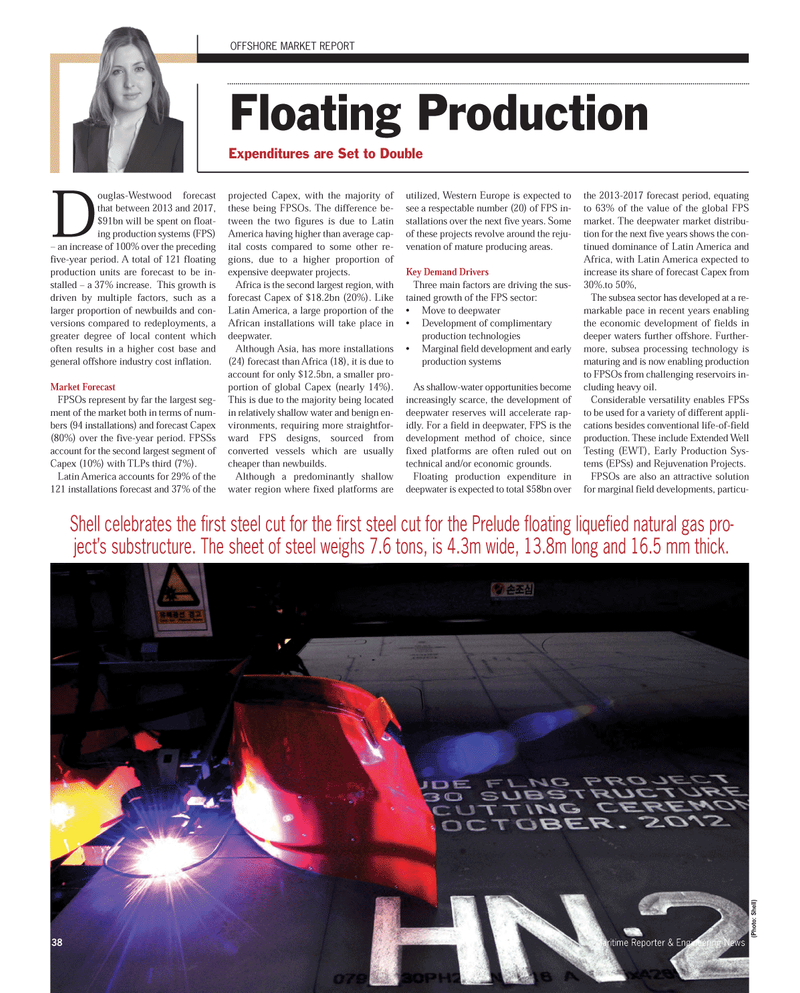
Page 38: of Maritime Reporter Magazine (November 2012)
Workboat Annual
Read this page in Pdf, Flash or Html5 edition of November 2012 Maritime Reporter Magazine
(Photo: Shell)Douglas-Westwood forecast that between 2013 and 2017,$91bn will be spent on float-ing production systems (FPS)? an increase of 100% over the preceding five-year period. A total of 121 floating production units are forecast to be in-stalled ? a 37% increase. This growth is driven by multiple factors, such as a larger proportion of newbuilds and con- versions compared to redeployments, a greater degree of local content which often results in a higher cost base andgeneral offshore industry cost inflation. Market Forecast FPSOs represent by far the largest seg- ment of the market both in terms of num- bers (94 installations) and forecast Capex (80%) over the five-year period. FPSSs account for the second largest segment of Capex (10%) with TLPs third (7%). Latin America accounts for 29% of the 121 installations forecast and 37% of theprojected Capex, with the majority of these being FPSOs. The difference be- tween the two figures is due to Latin America having higher than average cap- ital costs compared to some other re-gions, due to a higher proportion ofexpensive deepwater projects. Africa is the second largest region, with forecast Capex of $18.2bn (20%). Like Latin America, a large proportion of the African installations will take place in deepwater. Although Asia, has more installations (24) forecast than Africa (18), it is due to account for only $12.5bn, a smaller pro-portion of global Capex (nearly 14%). This is due to the majority being locatedin relatively shallow water and benign en- vironments, requiring more straightfor- ward FPS designs, sourced from converted vessels which are usually cheaper than newbuilds. Although a predominantly shallow water region where fixed platforms are utilized, Western Europe is expected to see a respectable number (20) of FPS in-stallations over the next five years. Some of these projects revolve around the reju- venation of mature producing areas. Key Demand Drivers Three main factors are driving the sus- tained growth of the FPS sector: Move to deepwater Development of complimentary production technologiesMarginal field development and early production systemsAs shallow-water opportunities become increasingly scarce, the development of deepwater reserves will accelerate rap- idly. For a field in deepwater, FPS is the development method of choice, since fixed platforms are often ruled out on technical and/or economic grounds. Floating production expenditure in deepwater is expected to total $58bn over the 2013-2017 forecast period, equatingto 63% of the value of the global FPS market. The deepwater market distribu- tion for the next five years shows the con- tinued dominance of Latin America and Africa, with Latin America expected to increase its share of forecast Capex from 30%.to 50%,The subsea sector has developed at a re- markable pace in recent years enablingthe economic development of fields in deeper waters further offshore. Further- more, subsea processing technology ismaturing and is now enabling production to FPSOs from challenging reservoirs in- cluding heavy oil. Considerable versatility enables FPSs to be used for a variety of different appli- cations besides conventional life-of-field production. These include Extended Well Testing (EWT), Early Production Sys- tems (EPSs) and Rejuvenation Projects. FPSOs are also an attractive solution for marginal field developments, particu- OFFSHORE MARKET REPORTFloating Production Expenditures are Set to Double Shell celebrates the first steel cut for the first steel cut for the Prelude floating liquefied natural gas pro- ject?s substructure. The sheet of steel weighs 7.6 tons, is 4.3m wide, 13.8m long and 16.5 mm thick. 38Maritime Reporter & Engineering News MR#11 (34-41):MR Template 11/3/2012 9:25 AM Page 38

 37
37

 39
39
